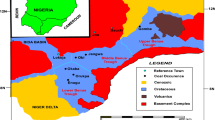Abstract
Carbonaceous materials (CM) from ores of varying preg-robbing activity from Barrick Goldstrike Mines Inc. (BGMI), Nevada, were characterized in terms of their functional group contents, hydrocarbon contents, elemental compositions and humic acid contents. Fourier transform infrared (FT-IR) analyses did not show the presence of hydrocarbons orcarboxylic, phenolic or suljhydrol functionalities. The FT-IR bands present included C=C stretching in aromatic rings and C-O-C stretching, indicating the presence of oxygen as ether linkages or thiocarbonyl functionality in the carbon matrix. Calculated atomic oxygen to carbon (O/C) ratios did not reveal a trend between the maturity of the CM and the preg-robbing behavior, possibly due to the low resolution inherent in electron microprobe analyses. However, the atomic O/C ratios agree with other chemical analyses, indicating that the organic carbon is very mature, similar to or higher than anthracite grade coal. Gas chromatography-mass spectrometry and nuclear magnetic resonance analyses corroborated the relatively featureless character of the carbon, indicating that the carbon structure is virtually completely aromatic (graphitic).
Similar content being viewed by others

References
Adams, M.D., 1989, Ph.D. Dissertation, University of the Wiitwatersrand, Johannesburg, South Africa, 387 pp.
Blom, L., Edelhausen, L., and Van Krevelen, D.W., 1957, “Chemical structures and properties of coal CVII - oxygen groups in coal and related products,” Fuel, Vol. 36, pp. 135–153.
Hatcher, P.G., Spiker, E., and Orem, W.H., 1985, “Oxidative origin of sedimentary humic acids, important carriers of metals,” Organics and Ore Deposits, W.E. Dean, ed., Denver Region Exploration Geologists Society, Wheat Ridge, CO, pp. 57–66.
Hausen, D.M., and Bucknam, C.H., 1985, “Study of preg-robbing in the cyanidation of carbonaceous gold ores from Carlin, Nevada,” Applied Mineralogy, Proceedings of the Second International Congress on Applied Mineralogy, W.C. Park, D.M. Hausen, and R.D. Hagni, eds., AIME, Warrendale, PA, pp. 833–856.
Hausen, D.M., and Park, W.C., 1985, “Observations on the association of gold mineralization with organic matter in Carlin-type ores,” Organics and Ore Deposits, W.E. Dean, ed., Denver Region Exploration Geologists Society, Wheat Ridge, CO, pp. 119–136.
Kuehn, C.A., and Rose, A.W., 1995, “Carlin gold deposits, Nevada: Origin in a deep zone of mixing between normally pressured and overpressured fluids,” Economic Geology, Vol. 90, pp. 17–36.
Leventhal, J.S., 1985, “Roles of organic matter in ore deposits,” Organics and Ore Deposits, W.E. Dean, ed., Denver Region Exploration Geologists Society, Wheat Ridge, CO, pp. 7–20.
Leventhal, J.S., and Hofstra, A., 1990, “Characterization of carbon in sediment-hosted disseminated gold deposits, north-central, Nevada,” Gold ′90, SME Symposium, Salt Lake City, UT, pp. 365–368.
Mantell, C.L., 1968, Carbon and Graphite Handbook. Interscience Publishers, New York, pp. 8–21.
Miller, J.D., and Sibrell, P.L., 1991, “The nature of gold adsorption from cyanide solutions by carbon,” EPD Congress ′91, The Minerals, Metals & Materials Society, Warrendale, PA, pp. 647–663.
Nakamizo, M., Honda, H., and Inagaki, M., 1978, “Raman spectra of ground natural graphite,” Carbon, Vol. 16, No. 4, pp. 281–283.
Nelson, J.H., MacDougall J.J., Baglin, F.G., Freeman D.W., Nadler, M., and Hendrix, J.L., 1982, “Characterization of Carlin-type gold ore by photoacoustic, Raman and EPS spectroscopy,” Applied Spectroscopy, Vol. 36, pp. 574–576.
Painter, P.C., Snyder, R.W., Starsinic, M., Coleman, M.M., Kuehn, D.W., and Davis, A., 1981, “Concerning the application of FT-IR to the study of coal: A critical assessment of band assignments and the application of spectral analysis programs,” Applied Spectroscopy, Vol. 35, No. 5, pp. 475–485.
Painter, P.C., Starsinic, M., Squires, E., and Davis, A.A., 1983, “Concerning the 1600 cm1 region in the i.r. spectrum of coal,” Fuel, Vol. 62, pp. 742–744.
Radtke, A.S., and Scheiner, B.J., 1970, “Studies of hydrothermal gold deposition (I). Carlin gold deposits, Nevada: The role of carbonaceous materials in gold deposition,” Economic Geology, Vol. 65, pp. 87–102.
Sibrell, P.L., Wan, R.Y., and Miller, J.D., 1990, “Spectroscopic analysis of passivation reactions for carbonaceous matter from Carlin trend ores,” Gold ′90, SME symposium, Salt Lake City, UT, pp. 355–363.
Sibrell, P.L., 1991, “The characterization and treatment of Carlin trend carbonaceous gold ores,” Ph.D. Dissertation, University of Utah, Salt Lake City, 196 pp.
Sibrell, P.L., and Miller, J.D., 1992, “Significance of graphitic structural features in gold adsorption by carbon,” Minerals and Metallurgical Processing, pp. 189–195.
Smith, G.C., 1968, “Discussion of refractory ore,” Carlin Gold Mining Company, Feb. 20, unpublished report.
Snyder, R.W., Painter, P.C., Havens, J.R., and Koenig, J.L., 1983, “The determination of hydroxyl groups in coal by Fourier Transform Infrared and 13C NMR spectroscopy,” Applied Spectroscopy, Vol. 37, No. 6, pp. 497–502.
Sobkowiak, M., and Painter, P., 1992, “Determination of the aliphatic and aromatic CH contents of coals by FT-IR: Studies of coal extracts,” Fuel, Vol. 71, pp. 1105–1125.
Starsinic, M., Rodney, L.T., Walker, P.L. Jr., and Painter, P.C., 1983, “FT-IR studies of Saran chars,” Carbon, Vol. 21, No. 1, pp. 69–74.
Stenebraten, J.F., Johnson, W.P., and McMullen, J., (to be published), “Characterization of Goldstrike ore carbonaceous matter, Part 2: Physical characteristics,” Minerals & Metallurgical Processing.
Tafuri, W. J., 1987, “Geology and geochemistry of the Mercur district, Utah,” Ph.D. Dissertation, University of Utah, Salt Lake City, pp. 126–127.
Tooke, P.B., and Grint, A., 1983, “Fourier transform infrared studies of coal,” Fuel, Vol. 63, pp. 1003–1008.
Tuinstra, F., and Koenig, J.L., 1970, “Raman spectrum of graphite,” The Journal of Chemical Physics” Vol. 53, No. 3, pp. 1126–1130.
Zerda, T.W., Andrzej, J. and Chmura, K. 1981, “Raman studies of coal,” Fuel, Vol. 60, pp. 375–378.
Author information
Authors and Affiliations
Additional information
Nonmeeting paper number 98–318. Discussion of this peerreviewed and approved paper is invited and must be submitted to SME prior to Feb. 29, 2000.
Rights and permissions
About this article
Cite this article
Stenebråten, J.F., Johnson, W.P. & Brosnahan, D.R. Characterization of Goldstrike ore carbonaceous material. Mining, Metallurgy & Exploration 16, 37–43 (1999). https://doi.org/10.1007/BF03402817
Received:
Accepted:
Published:
Issue Date:
DOI: https://doi.org/10.1007/BF03402817



